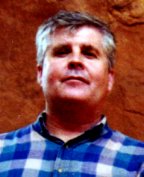Dr. Dennis Swift Ph.D.

In August of 1999, Don Patton and myself ventured back to Acambaro to seek answers to such questions. By chance while having dinner at a local Acambaro, restaurant we met Ernesto Narrvete Marines. In the 1970's Ernesto was commander of the Federal Police for the Celaya zone of Guanauanto, which includes the Acambaro, area. Ernesto received a tip one night in 1978 that illegal excavations were taking place on Chivo (goat) Mountain and that the artifacts were being traded for pistols, rifles, machine guns as well as other weapons on the black market. Commander Ernesto Marines, who was trained at Scotland Yard, conducted a thorough investigation. The investigation revealed that artifacts dug up on Chivo Mountain were being taken to the border at Laredo, Texas and traded for arms, which was a Federal crime.
When Ernesto apprehended Jaime Aquirre and Raul Hernandez on Chivo Mountain had in their possession 3,300 Julsrud type pottery figurines. The commander catalogued the collection as evidence and told us that he personally observed nine dinosaur figurines. Ernesto drew a sketch for us of the dinosaurs he had seen in the collection. These illegally excavated artifacts were handed over to Dr. Luis Moto, Mayor of Acambaro in 1978-1979, and kept in City Hall.
The artifacts were accepted as genuine by the Federal Court of Mexico when they were used as prima facie evidence in the trial of Jaime Aquirre and Raul Hernandez. Jaime and Raul were sentenced to the Federal prison in Mexico City where they are still serving time. If Jaime and Raul had been peddling phony pottery, fakes of modern manufacture, they would not have been sentenced to prison. Furthermore, the fact that Jaime and Raul were sentenced for trading genuine artifacts should silence the critics who say that no other Julsrud type ceramic pieces have ever been found by others.
While in Acambaro we were introduced to Dr. J. Antonio Villia Hennejon who has a medical practice in Guadalajara and Acambaro, Mexico. Dr. Herrejon personally excavated ceramic artifacts on Bull Mountain and Goat Mountain from 1950 to 1955.
Dr. Herrejon insisted that the ground he dug in was hard packed with no loose soil. This was confirmed in personal conservation with other participants in such excavations who remain in Acambaro; i.e. Porfirio Martinez Espinoseo, who accompanied us to Goat mountain and showed us where in his youth he had excavated hundreds of ceramic artifacts. Twice Dr. Herrejon accompanied Julsrud on burros to an area below Goat Mountain, near a lake. There he said on terrain that was overgrown with grass and cactus, they dug up many ceramic pottery pieces including enough dinosaur figurines to fill two bags to be carried back on a burro.
Antonio Herrejon recalled that in the 1940's and early 1950's virtually nothing was known about dinosaurs in Mexico. They had no books, pamphlets, matchbox covers, movies or other information about dinosaurs. Herrejon postulated that the only dinosaur skeleton on display in Mexico in the 1940's was that of a brontosaurus at the Chupa railroad station in Mexico City.
The figurines he saw in the late 1940's and early 1950's were simply curious looking creatures that many years later were correctly identified as particular dinosaurs. Amazingly, the Julsrud dinosaur figurine matches the color drawing of an Amargasaurus cazaai in the Japanese dinosaur book. The narrator quickly picks up another dinosaur figure and thumbs through the dinosaur book. This figure is very similar to the Sauraloplus osborni as drawn in the Japanese dinosaur book. The narrator ponders the perplexing problem that ancient people about 4,500 years ago must have seen dinosaurs because they could not have known what they looked like by merely seeing their skeletons in the ground. The narrator points out that when modern man found dinosaur skeletons such as Sir Richard Owen, that the life sized models of Megalosaurus, Iquanodon and Hylaeosaurus were ridiculously inaccurate.